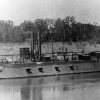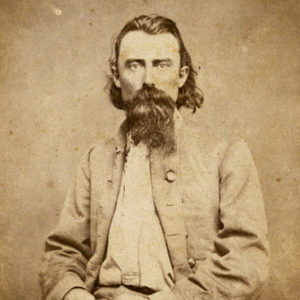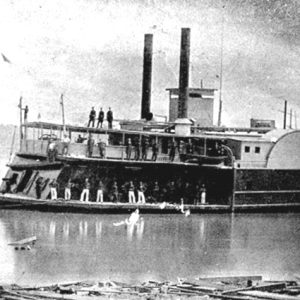calsfoundation@cals.org
Sinking of USS Queen City
| Location: | White River, Clarendon (Monroe County) |
| Date: | June 24, 1864 |
| Principal Commanders: | Acting Master Michael Hickey (US); Brigadier General Joe Shelby (CS) |
| Forces Engaged: | USS Queen City, tinclad river gunboat (US); one cavalry brigade (CS) |
| Estimated Casualties: | At least 20 (US); 30 (CS) |
| Result: | Confederate victory |
The USS Queen City was captured and sunk during an engagement on the White River in June 1864. It is the only example of a warship’s being captured by land forces in Arkansas.
The Union stationed the Queen City on the White River in eastern Arkansas to protect barges going up the river to DeValls Bluff (Prairie County) and to combat any Confederate troops in the area. DeValls Bluff was vital to the Union forces in occupied Little Rock (Pulaski County) at the time, because much of their supplies were brought up the White from the Mississippi River and placed on a railroad in DeValls Bluff that then carried the goods to Little Rock. If the White were closed to navigation, Union forces could be starved out of Little Rock.
In May and June 1864, Confederate Brigadier General Joseph Shelby led his brigade of cavalry and artillery from Camden (Ouachita County) to the northern part of the state to take command of all Confederate forces north of the Arkansas River. Shelby was tasked to gather men to serve in the army and to stop bands of deserters, who did not formally belong to any army, from attacking civilians. He soon moved down to the White River to attack Union boats.
Arriving near Clarendon on the afternoon of June 23, 1864, Shelby learned that a Union vessel was anchored in the city and immediately set out to capture it. After stopping all travelers to ensure secrecy, the Confederates moved into the town and wheeled their cannon to within 200 yards of the ship. At 3:00 a.m. on June 24, Shelby’s men opened fire on the Queen City. After a few moments of fighting, the ship was disabled and drifted down the river. After its commander surrendered, the Confederates pulled the boat back upriver to Clarendon. Union casualties reportedly consisted of at least six men killed and nine wounded. The wounded men and about half the crew were captured. The other half swam to the opposite shore. The Confederates did not list any casualties.
The Confederates immediately set out to take everything useful from the ship and even removed several cannon, although it is unclear how many. Fearful of the Union reinforcements that were sure to be coming down the White, Shelby ordered the boat destroyed. The magazines were opened and a fire set, causing the vessel to explode. Soon, three Union ships arrived from DeValls Bluff and engaged the Confederates on the bank. After a short engagement, the Confederates were forced to retreat out of town. Union sailors captured at least one cannon from the Queen City and freed several prisoners the Confederates had captured from the ship. They also set fire to several structures that had protected the Confederates during the battle; the fires spread and almost destroyed the town.
On June 26, 3,000 men arrived from DeValls Bluff under the command of Brigadier General Eugene Carr and chased Shelby from Clarendon. Over the next three days, the two forces engaged in countless skirmishes across east Arkansas, but Shelby escaped. He reported suffering thirty casualties, while Federal troops lost twenty men killed or wounded and an unknown number captured.
Salvage diving conducted after the war recovered the ship’s machinery, while modern marine archaeological surveys performed by the University of Missouri–Columbia and the National Park Service discovered its remaining sunken structure.
A text panel was installed in front of the Clarendon City Hall recounts the sinking of the Queen City.
For additional information:
Christ, Mark K. “The Queen City Was a Helpless Wreck: J. O. Shelby’s Summer of ’64.” In “The Earth Reeled and the Trees Trembled,” Civil War Arkansas, 1863–1864. Little Rock: Old State House Museum, 2007.
DeBlack, Thomas A. With Fire and Sword: Arkansas, 1861–1874. Fayetteville: University of Arkansas Press, 2003.
Edwards, John M. Shelby and His Men, or, the War in the West. Kansas City, MO: Hudson-Kimberly, 1897.
Roth, Don. General J. O. Shelby at Clarendon, Arkansas: The Capture and Destruction of the U.S.S. Queen City. Iowa City, IA: Camp Pope Publishing, 2017.
David Sesser
Nevada County Depot and Museum
 Civil War through Reconstruction, 1861 through 1874
Civil War through Reconstruction, 1861 through 1874 Military
Military Steamboats (Civil War)
Steamboats (Civil War) Transportation
Transportation Joseph Shelby
Joseph Shelby  USS Queen City
USS Queen City 




Comments
No comments on this entry yet.